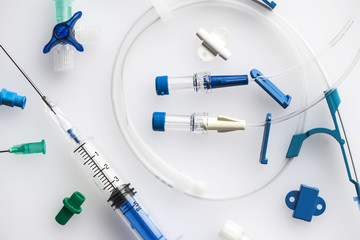
Understanding and Preventing Catheter-Related Bloodstream Infections
Based on the Infusion Therapy Standards of Practice, 9th Edition – Standard 47: Vascular Access Device-Related Infection
Catheter-related bloodstream infections (CRBSIs) are among the most serious complications associated with vascular access devices (VADs), especially central venous catheters. These infections not only pose a significant threat to patient safety but also result in prolonged hospital stays, increased healthcare costs, and elevated mortality rates. Recognizing and addressing CRBSIs is a key component of safe infusion therapy practices.
What Are CRBSIs?
CRBSIs occur when microorganisms enter the bloodstream through or around a vascular access device. They are typically confirmed by laboratory evidence that the same organism is present both in the catheter and in a blood culture drawn from a peripheral vein, without another identifiable source of infection. These infections are often preventable with evidence-based practices.
Risk Factors
Several factors increase the risk of CRBSIs, including:
- Prolonged catheter dwell time
- Poor hand hygiene or improper aseptic technique during insertion or care
- Infrequent dressing changes or improper maintenance
- Use of high-risk insertion sites (e.g., femoral vein)
- Immunocompromised status of the patient
Prevention Strategies (Standard 47 Highlights)
According to Standard 47: Vascular Access Device-Related Infection from the Infusion Therapy Standards of Practice, 9th Edition, the following measures are essential in CRBSI prevention:
- Hand Hygiene: Perform hand hygiene before and after all VAD care and insertion procedures using alcohol-based hand rub or soap and water.
- Maximal Barrier Precautions: During central line insertion, providers must wear a cap, mask, sterile gown, and gloves. The patient should be fully draped with a sterile barrier.
- Skin Antisepsis: Use a >0.5% chlorhexidine gluconate solution with alcohol for skin preparation before catheter insertion and during dressing changes.
- Site Selection: Avoid the femoral vein for central venous access in adult patients due to a higher infection risk. Use ultrasound guidance to reduce insertion-related complications.
- Daily Review of Line Necessity: Prompt removal of unnecessary catheters is vital to minimizing infection risk.
- Antimicrobial Impregnated Catheters and Dressings: These may be considered for patients requiring long-term central venous access or who are at high risk of infection.
- Catheter Hub and Port Decontamination: Disinfect catheter hubs, needleless connectors, and injection ports before each access.
Signs and Symptoms of CRBSI
- Fever, chills, or rigors without an obvious source
- Redness, swelling, or discharge at the insertion site
- Elevated white blood cell count
- Hypotension or hemodynamic instability in severe cases
Prompt recognition and diagnostic evaluation are crucial. Suspected CRBSIs should trigger immediate blood cultures, catheter site inspection, and potentially, catheter removal if appropriate.
Treatment of CRBSIs
Once confirmed, treatment involves:
- Targeted antimicrobial therapy
- Possible removal of the implicated catheter
- Management of sepsis or related systemic complications
- Monitoring for secondary infections or complications such as endocarditis
Pedagogy Education’s Courses on CRBSI Prevention
To further your knowledge and stay current on best practices, Pedagogy Continuing Nurse Education offers two comprehensive online courses dedicated to the prevention and management of CRBSIs:
✅ Combating CLABSI
This course outlines practical strategies to prevent central line-associated bloodstream infections (CLABSI) and offers current evidence-based practices for reducing infection risks across care settings.
✅ Goal: Zero Catheter Related Blood Stream Infections
Focusing on achieving zero CRBSI events, this course empowers healthcare professionals to lead quality improvement efforts through education, surveillance, and policy development.
Benefits of Online Continuing Education
- Learn at your own pace from any location
- Stay up to date with the latest Infusion Therapy Standards
- Earn accredited contact hours for professional development
- Immediately applicable clinical knowledge for frontline care
By investing in continued education, nurses and infusion specialists can play a direct role in preventing CRBSIs and improving patient outcomes.
References
- Gorski, L. A., Hadaway, L., Hagle, M. E., McGoldrick, M., Orr, M., & Doellman, D. (2021). Infusion therapy standards of practice. Journal of Infusion Nursing, 44(1S), S1–S224.
- Centers for Disease Control and Prevention. (2020). Guidelines for the Prevention of Intravascular Catheter-Related Infections.
- Pedagogy Continuing Nurse Education. https://pedagogyeducation.com

